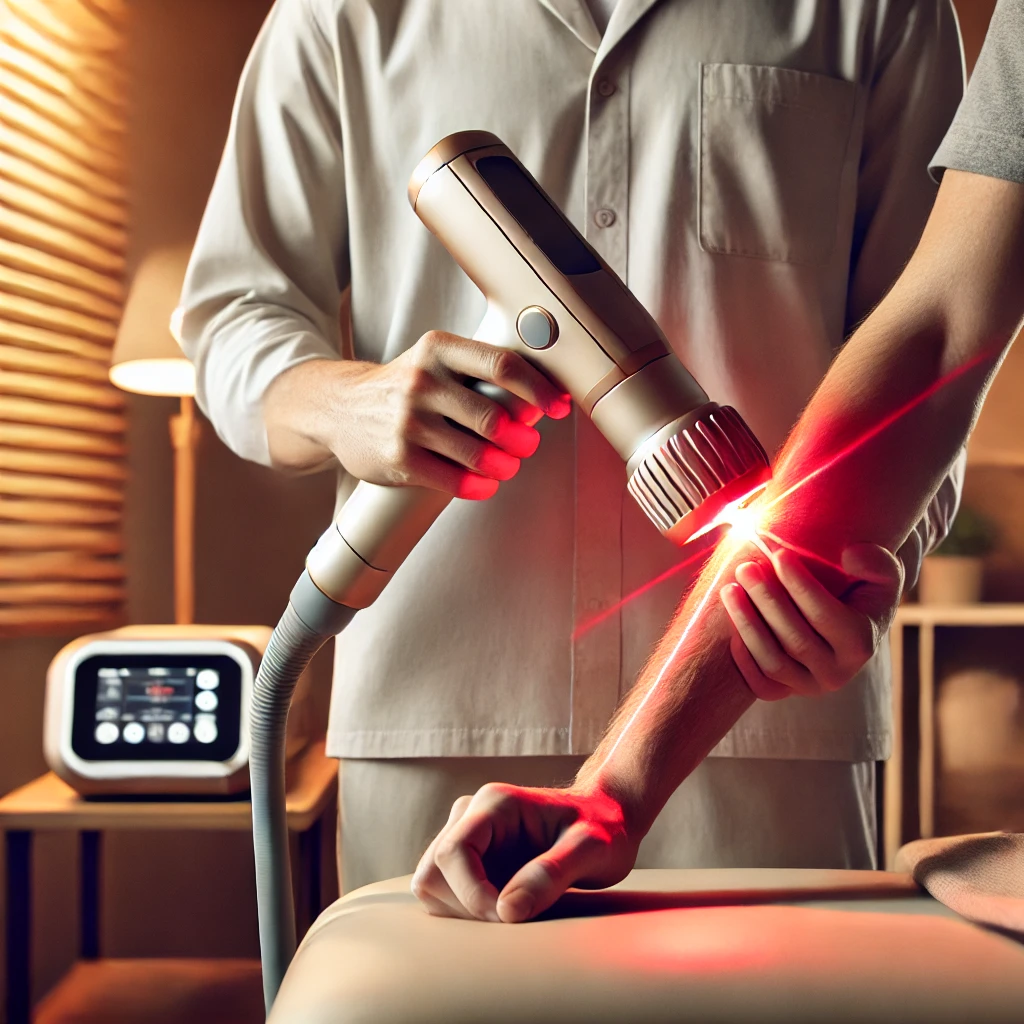|
Getting your Trinity Audio player ready...
|
Effectiveness of Low-Intensity Laser Therapy (LLLT)

Low-Intensity Laser Therapy (LLLT), also known as photobiomodulation, is a non-invasive treatment that uses low-power laser light to promote healing and reduce pain. Unlike surgical lasers, which generate heat to cut tissue, LLLT uses wavelengths between 600 and 1100 nanometers (nm) to stimulate cellular activity without causing thermal damage. Studies demonstrate LLLT’s efficacy across a range of musculoskeletal conditions, including tendinopathies, myofascial pain, and arthritis, making it a valuable tool in clinical practice (Chung et al., 2012).
Mechanism of Action
LLLT works by emitting light in the red or near-infrared spectrum, which is absorbed by mitochondria in cells. This absorption stimulates the production of adenosine triphosphate (ATP), thereby enhancing cellular function and promoting tissue repair. Additionally, LLLT has been shown to reduce oxidative stress, decrease inflammatory mediators, and increase blood flow, all of which help reduce pain and improve healing (Hamblin, 2016).
Conditions Treated with LLLT
1. Osteoarthritis (OA)
- LLLT is effective in managing symptoms of osteoarthritis, particularly in the knee. Studies indicate that LLLT can reduce pain, improve joint mobility, and enhance quality of life in OA patients (Huang et al., 2015).
- Recommended Settings: Wavelengths of 780–850 nm, with a dosage of 4–6 J/cm² per point, applied 2–3 times per week.
- Number of Sessions: 10–15 sessions over 4–6 weeks, with follow-up sessions as needed.
- Prognosis: Most patients experience pain reduction and functional improvements within 2–4 weeks, with benefits lasting up to 6 months (Wang et al., 2016).
2. Tendinopathies (e.g., Achilles, Patellar Tendinopathy)
- LLLT is commonly used for chronic tendinopathies that are resistant to conservative management. It promotes collagen synthesis and reduces inflammation in tendons, offering pain relief and functional improvements (Stergioulas et al., 2008).
- Recommended Settings: Wavelengths of 810–830 nm, with a dose of 5–8 J/cm², targeting affected tendons.
- Number of Sessions: 2–3 sessions per week for 4–5 weeks.
- Prognosis: Tendinopathy patients often report pain reduction within the first few weeks of treatment, with sustained improvements observed up to one year post-treatment (Bjordal et al., 2006).
3. Myofascial Pain Syndrome
- For myofascial pain syndrome, LLLT can reduce muscle tenderness and improve circulation in trigger points. This helps alleviate pain and improve mobility in affected muscles (Gur et al., 2004).
- Recommended Settings: Wavelengths of 830–904 nm, with 3–6 J/cm² applied to each trigger point.
- Number of Sessions: Typically, 10–12 sessions over 4–5 weeks.
- Prognosis: Patients often experience gradual pain reduction within the first few treatments, with benefits lasting several months (Vanti et al., 2015).
4. Rheumatoid Arthritis (RA)
- LLLT may offer pain relief and reduce joint swelling in patients with rheumatoid arthritis. While more research is needed, studies suggest it may help decrease inflammatory markers and improve hand grip strength in RA (Yousefi-Nooraie et al., 2008).
- Recommended Settings: Wavelengths of 800–904 nm, with 2–4 J/cm² per joint area.
- Number of Sessions: 2–3 sessions per week for 6–8 weeks.
- Prognosis: Moderate pain relief and improved joint function typically occur after 3–4 weeks, with effects lasting several months (Yousefi-Nooraie et al., 2008).
Contraindications
LLLT is generally safe, but there are specific contraindications, including:
- Pregnancy, particularly over the abdomen and lower back
- Active malignancy in the treatment area
- Thyroid gland irradiation, as it may alter thyroid function
- Photosensitivity or patients on photosensitizing medication
- Direct irradiation of the eyes
Patients with certain skin conditions, like eczema or psoriasis, may need special consideration, as LLLT can exacerbate these conditions.
Expected Prognosis by Condition
- Osteoarthritis: Significant pain relief and functional improvements, with up to 6 months of sustained benefits.
- Tendinopathies: Symptom relief within weeks and sustained improvement over a year in many cases.
- Myofascial Pain: Gradual reduction in pain and muscle tenderness over several weeks.
- Rheumatoid Arthritis: Improved grip strength and pain reduction, typically lasting 3–6 months.
References
- Bjordal, J. M., Johnson, M. I., Iversen, V., Aimbire, F., & Lopes-Martins, R. A. B. (2006). Low-level laser therapy in acute pain: A systematic review of possible mechanisms of action and clinical effects in randomized placebo-controlled trials. Photomedicine and Laser Surgery, 24(2), 158-168.
- Chung, H., Dai, T., Sharma, S. K., Huang, Y. Y., Carroll, J. D., & Hamblin, M. R. (2012). The nuts and bolts of low-level laser (light) therapy. Annals of Biomedical Engineering, 40(2), 516-533.
- Gur, A., Sarac, A. J., Cevik, R., Altindag, O., & Sarac, S. (2004). Efficacy of 904 nm gallium arsenide low-level laser therapy in the management of chronic myofascial pain in the neck: A double-blind and randomized-controlled trial. Lasers in Surgery and Medicine, 35(3), 229-235.
- Hamblin, M. R. (2016). Mechanisms and applications of the anti-inflammatory effects of photobiomodulation. AIMS Biophysics, 3(3), 337-361.
- Huang, Z., Ma, J., Chen, J., Shen, B., & Pei, F. (2015). The effectiveness of low-level laser therapy for nonspecific chronic low back
